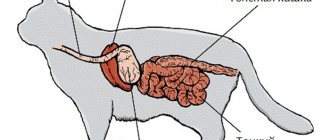Vaccination will protect the animal from many diseases. People believe that vaccinating cats against toxoplasmosis can protect them from infection. But there is no specific vaccine. Experts assure that such a solution will not be made. A complex injection will reduce the risk of infection, but if the owner does not carry out preventive examinations and hygiene procedures, the risk of infection will increase, even when the cat is vaccinated.
Vaccine or fiction
Toxoplasmosis is caused by protozoa. They can cause pathology in both humans and animals. The pathogen is able to penetrate the cells of the body, where it is no longer affected by various negative factors, including drugs.
Important: toxoplasmosis is especially dangerous during pregnancy, since protozoa easily penetrate the placental barrier, causing serious developmental disorders.
With toxoplasmosis, symptoms may be completely absent, but with primary infection the clinical picture is especially clear. Children, patients with weak immune systems and pregnant women are most susceptible to it. It is they who are interested in the question: can toxoplasmosis be prevented through vaccination.
In order not to reassure people, let us immediately note that there is no vaccine against toxoplasmosis today and, most likely, it will not be created.
There are many reasons for this:
- The pathology is not epidemiologically dangerous. In other words, outbreaks of the disease have not been observed before, and infection occurs extremely rarely. Thus, vaccination against toxoplasmosis is not vital.
- The cause of the pathology is protozoa. It should be noted here that the vaccine involves the administration of a substance containing either weakened viruses or antibodies to them. In the case of a non-infectious agent, it is simply impossible to create a vaccine.
Thus, it is impossible to artificially force the immune system to resist toxoplasma. Today, people are not vaccinated, just as vaccinations for animals have not yet been created.
Our advantages
Vaccine against toxoplasmosis in cats Rostov-on-Don - we have the solution.
That's why they choose us to bake.
Pet taxi
We will help your friend at home, or transport him to the clinic, using our own zoo-taxi
Seven days a week
Our only day off is January 1st. You can contact us any day, we work around the clock, without days off or breaks.
New technologies
The clinic’s equipment makes it possible to perform operations that are inaccessible to other veterinary hospitals in the city.
Good plus
You can purchase medicines and food for your animal directly from our clinic.
Let's be professional
Our doctors are professionals with extensive experience and a responsible approach to their work.
Let's improve
We are members of the Union of Pet Business Enterprises of Russia, initiators of programs for the development of progressive veterinary medicine and animal care.
Is a vaccine necessary?
In order to understand whether your body needs protection from toxoplasma, you need to find out what changes occur during toxoplasmosis.
As with any other pathogen, when Toxoplasma enters the body, a reaction of the immune system is observed, expressed in the form of the production of antibodies. In particular, with this disease, IgG immunoglobulin is produced. It is aimed at suppressing the activity of the pathogen.
Diagnosis of pathology is based precisely on whether IgG immunoglobulin is detected in the patient’s blood or not.
It is important to emphasize that after an infection, immunity lasts for life. If a woman has IgM immunoglobulin, detected before the baby is conceived, the condition does not pose any danger to the child. A test that detects immunoglobulin E may also be prescribed.
We serve all areas
We serve all areas of the city of Rostov-on-Don. We go to the house.
- Feline toxoplasmosis vaccine 1st Street
- Vaccine against toxoplasmosis in cats Sverdlovskaya street
- Vaccine against toxoplasmosis in cats Varfolomeeva Street
- Vaccine against toxoplasmosis in cats Izobilnaya Street
- Vaccine against toxoplasmosis in cats Lawn 3rd Lane
- Vaccine against toxoplasmosis in cats Raskatny 10th Lane
- Vaccine against toxoplasmosis in cats Milyutinsky Lane
- Vaccine against toxoplasmosis in cats Tsushima Lane
- Vaccine against toxoplasmosis in cats Committee Lane
- Vaccine against toxoplasmosis in cats Stolyarny Lane
- Vaccine against toxoplasmosis in cats Ivakhnenko street
- Vaccine against toxoplasmosis in cats Loud Lane
- Vaccine against toxoplasmosis in cats Privokzalnaya Square
- Vaccine against toxoplasmosis in cats Sputnik 1st Lane
- Vaccine against toxoplasmosis in cats Glubokiy Lane
- Vaccine against toxoplasmosis in cats Yasnaya Street
- Vaccine against toxoplasmosis in cats Onezhskaya street
- Vaccine against toxoplasmosis in cats Krasny Partizan Lane
- Vaccine against toxoplasmosis in cats Peskova street
- Vaccine against toxoplasmosis in cats Mozdoksky Lane
Is there a vaccine against toxoplasmosis?
No, and it is unlikely to appear. The fact is that toxoplasmosis is not included in the list of epidemiologically dangerous diseases, therefore there is no need for a vaccine.
In addition, toxoplasmosis is not caused by an infectious agent, but by a parasite (intracellular). Therefore, a vaccine against toxoplasmosis is unlikely to become available. There is no vaccination against this disease for animals either.
However, veterinarians say that a preventive drug against toxoplasmosis for animals is now being developed and tested, and more than one.
Do you still think that getting rid of parasites is difficult?
Judging by the fact that you are now reading these lines, victory in the fight against parasites is not yet on your side.
Have you already thought about surgery? This is understandable, because you have only one internal body, and its proper functioning is the key to health and well-being. Poor mood, lack of appetite, insomnia, immune system dysfunction, intestinal dysbiosis and abdominal pain. All these symptoms are familiar to you firsthand.
But perhaps it would be more correct to treat not the effect, but the cause? We recommend reading the story of Victoria Dvornichenko, how you can get rid of parasites without harming yourself. Read the article >>
Toxoplasmosis and pregnancy
If you become infected with toxoplasma during pregnancy, there is a chance that the expectant mother will infect her child with toxoplasmosis.
The longer the pregnancy, the higher the risk of infection of the fetus with toxoplasma. However, oddly enough, the likelihood of consequences decreases, up to their complete absence (unless, of course, you take into account the possibility of developing congenital toxoplasmosis, about which information will be below).
The risks of transmitting the parasite to the fetus, depending on the stage of pregnancy, look something like this:
- I trimester - 15%;
- II trimester - 30%;
- III trimester - 60%.
Toxoplasmosis, how to treat it: medications and folk remedies
- Treatment of toxoplasmosis with folk remedies: recipes and application
- Toxoplasmosis during pregnancy: symptoms, diagnosis and treatment
- Toxoplasmosis of the eye: causes, symptoms, diagnosis and treatment
- Analysis for toxoplasmosis: how to take it and interpretation of the results
Considering the immaturity of many systems of a small body, including the immune system, a disease in a child can lead to the most serious consequences. These include hydrocephalus, damage to various organs of the nervous system, including the brain, disturbances in the functioning of the organs of vision, and more.
If infection occurs in the early stages, the likelihood of premature termination of pregnancy greatly increases.
Toxoplasmosis (Toxoplasma gondii)
Toxoplasma gondii is a ubiquitous pathogen belonging to the phylum Protozoa, the class Sporozoa, and the order Coccidia. In humans, T. gondii is dangerous only for pregnant women, since in 40% of cases this means vertical transmission of the pathogen to the fetus with subsequent severe lesions in the majority. However, the prevalence of toxoplasmosis among various groups of immunocompromised individuals and its clinical significance should be reconsidered.
The main host of the parasite is cats, which become infected by eating infected mice and other animals. Toxoplasmosis exists in three forms: trophozoid, cyst and oocyst, with the first being an invasive form and the second being a latent form. Oocysts only exist in cats. A person becomes infected with Toxoplasmosis by eating raw, undercooked meat, infected animals (lamb), or food contaminated with cat feces . After infection, parasitemia occurs, when damage to the fetus is possible, then the cysts enter the body tissues: especially the brain and striated muscles, where they exist indefinitely. They either undergo calcification or are destroyed with the release of toxoplasma and the penetration of the latter into healthy cells, which entails a relapse of the disease.
If the mother is infected during pregnancy, transplacental transmission of the infection to the fetus is possible. The incidence of congenital toxoplasmosis ranges from 1 in 1000 to 1 in 10,000 live births . At the same time, toxoplasmosis can be transmitted through blood and during organ transplantation, which is facilitated by deep immunosuppression. Cases of infection through damaged skin have been described.
Congenital toxoplasmosis is a rare but potentially dangerous disease. According to recent epidemiological studies, the incidence of congenital toxoplasmosis in the United States is 1 per 10,000 newborns, with 400-4000 cases of the disease recorded per year. In other geographic regions, these rates vary greatly. For example, in Belgium and France they reach 2-3 per 1000 births, i.e. 20 times higher. In Russia, the incidence of congenital toxoplasmosis varies between 1 in 1000-8000, and infection with toxoplasma in women of childbearing age is 20-30%. The seroconversion rate during pregnancy is 1-2/1000. In approximately 1/3 of cases (up to 60%), infection of the fetus occurs: a third of newborns have clinical forms, 2/3 have subclinical forms of the disease. The level of infection of the fetus increases with the duration of pregnancy in which the infection occurred, being minimal in the period shortly after conception: for the first trimester - 14% (clinical forms about 11%), for the second trimester - 29%, for the third trimester - 59% ( Lower figures can be found in the literature). However, the severity of infection in the fetus and perinatal mortality are higher when the pregnant woman becomes ill in the first trimester. The risk of congenital T. is during pregnancy (after menstruation): 0-2 weeks - 0%, 3-10 weeks - 2%, 27-30 weeks - 22%, 31-34 weeks - 67%. Each individual woman can have only one child with T. Despite 20 years of research, the role of T. as a possible cause of repeated abortions remains unclear.
Clinical manifestations
In 70-90% of cases of congenital toxoplasmosis in newborns, there are no symptoms; the disease begins to manifest itself after months and years. Symptoms of congenital toxoplasmosis at birth may include rash, generalized lymphadenopathy, enlarged liver and spleen, jaundice, and thrombocytopenia. As a consequence of intrauterine meningoencephalitis, microcephaly, hydrocephalus, choreoretinitis, convulsive syndrome and deafness develop. Foci of calcification in the brain can be detected by radiography, ultrasound, and computed tomography.
In 1985, the United States spent more than $221 million on the treatment, upbringing and education of such children (about 3,300 people). In 2000, this amount already exceeded $1 billion. It has been shown that the introduction in Finland of a national program of prolonged screening to determine the likelihood of having a child with congenital toxoplasmosis would save up to $2.1 million annually.
Infection acquired after birth is usually asymptomatic. The incubation period ranges from 4 to 21 days and averages 7 days. In a small percentage of cases, an active process may develop, manifested by such nonspecific symptoms as fever, malaise, myalgia, and lymphadenopathy. Patients may also experience a mononucleosis-like syndrome in combination with a maculopapular rash and hepatosplenomegaly. The clinical course is favorable; as a rule, these symptoms resolve without treatment. Complications such as myocarditis, pericarditis, and pneumonitis rarely occur.
Ocular toxoplasmosis often develops in the congenital form of the disease, but is also observed in a small percentage of cases during infection during life. Signs of eye involvement in the infectious process are blurred vision and characteristic retinal infiltrates, which develop in 85% of young people after congenital toxoplasmosis. Ocular toxoplasmosis may reactivate several years after the initial infection.
In patients with chronic immunodeficiency conditions, including HIV infection, reactivation of chronic infection can lead to encephalitis, pneumonitis, and generalized toxoplasmosis. Infants born to mothers with HIV infection or other immunodeficiency and chronic T. gondii infection may acquire toxoplasmosis in utero as a result of reactivation of the maternal infection.
Diagnostics
1. Histological examination of lymph nodes with identification of the pathogen: labor-intensive and insensitive
2. Isolation of Toxoplasma in culture: tissue culture (mouse fibroblasts) is a faster method, and intraperitoneal inoculation in mice (6 weeks followed by determination of specific antibodies) is a more sensitive method
3. Determination of Toxoplasma antigen by immunofluorescence (sensitivity is limited)
4. Serological tests (8 methods). Ig G appears 1-2 months after infection and is detected in low titers for several years; Ig M appears within 1 week of infection and is detected within several weeks. The absence of Ig M and the presence of Ig G in titers above 1:1000 indicates the presence of infection in the past . The diagnosis of acute Toxoplasmosis in a pregnant woman is based on the appearance of specific Ig G in the blood (seroconversion) or an increase in its titer after 3 or more weeks.
5. Determination of pathogen DNA: PCR in amniotic fluid is an accurate and rapid method for diagnosing fetal infection
6. Nonspecific tests (in a newborn): leukocytosis, ultrasound, liver enzymes. Ultrasound: expansion of the ventricles of the brain, increased echogenicity of brain tissue, liver, thickening and increased echogenicity of the placenta, hepatomegaly, ascites, pericardial and pleural effusion.
The main diagnostic method is serological. Immunoglobulin G (determined by indirect fluorescence reaction or enzyme-linked immunosorbent assay) reaches peak concentrations 1-2 months after infection and remains positive indefinitely. In patients with seroconversion or a fourfold increase in IgG titer, specific IgM should be determined to confirm acute infection. The presence of IgM confirms acute or recent infection. Enzyme immunoassay is more sensitive in detecting IgM. IgM is detected 2 weeks after infection, reaching a peak concentration after 1 month, and usually disappears after 6-9 months, but can persist in some cases for more than 2 years, making it difficult to differentiate between acute and previous infections. Determination of IgA and IgE, the level of which increases faster than IgM, is useful in diagnosing congenital toxoplasmosis and examining patients, in particular pregnant women, for whom information about the duration and stage of the infectious process is extremely important.
If toxoplasmosis is suspected in newborns, a study of the visual, auditory and nervous systems, lumbar puncture, and computed tomography of the head should be performed. You should also try to isolate the pathogen from the placenta, umbilical cord, and blood by infecting mice. An alternative may be to isolate the pathogen from cerebrospinal or amniotic fluid using PCR. Transplacentally transferred IgG ceases to be detected after 6-12 months. In patients with HIV infection, there may be variability in the IgG titer and absence of IgM, therefore, with seroconversion and an increase in the IgG titer by 4 times, an active infection should be diagnosed. In HIV-infected persons seropositive for Toxoplasma, the diagnosis of encephalitis is established clinically, and only if therapy against T.gondii is ineffective should antigens or DNA be isolated from biopsy material or cerebrospinal fluid.
It is possible to isolate the pathogen during infection of laboratory animals, but the conclusion that Toxoplasma was found in this preparation does not carry any positive information, except that the patient was infected with them. Also, the absence of a pathogen in the preparation cannot serve as a basis for excluding toxoplasmosis, since it could simply not have gotten into the test material.
Features of diagnosis in pregnant women
Serological screening of pregnant women is carried out by determining antibodies in the blood - IgM and IgG. As a rule, the Sabin-Feldman test is used to determine IgG, and the immunofluorescence reaction (ELISA-IgM) is used to determine IgM. The absence of IgM in the blood allows one to exclude infection with toxoplasmosis; its presence is not an absolute criterion for infection. Of great concern is the possibility of false-positive results, as they lead to serious consequences (termination of pregnancy, intensive diagnostic and therapeutic procedures, which can also lead to termination of a normal pregnancy). All cases of positive results should be carefully studied in laboratories with experience in diagnosing toxoplasmosis, and titers should be determined over time. Positive results of serological tests should be complemented by fetal examination, including ultrasound, amniocentesis and umbilical cord puncture.
Polymerase chain reaction (PCR), based on the detection of Toxoplasma gondii DNA in amniotic fluid, which was considered the most reliable and safe diagnostic method, has now almost completely replaced fetal blood testing. The sensitivity of PCR reaches 64%, the predictive value of a negative result is 87.8%, the specificity is 100% and the predictive value of a positive result is 100%. Research shows that the sensitivity of the reaction is significantly increased if infection occurs between 17 and 22 weeks of pregnancy. PCR allows diagnosis at earlier stages of pregnancy (18 weeks of gestation), while the test for detecting IgM in the blood of the fetus becomes positive only by 22 weeks, and allows early treatment or termination of pregnancy up to 24 weeks. A negative PCR result at any stage of gestation completely excludes the presence of congenital toxoplasmosis.
The main criteria for interpreting the results of serological screening for Toxoplasma gondii are presented in the table:
| IgG | IgM | Interpretation of analysis results |
| negative | negative | No serological confirmation of Toxoplasma gondii infection |
| negative | doubtful | Early stage of acute infection or false positive reaction to IgM. Repeated examination is necessary; if the results remain similar, the patient is most likely not infected |
| negative | positive | Early stage of acute infection or false positive reaction to IgM. Repeated examination is necessary; if the results remain similar, the patient is most likely not infected |
| doubtful | negative | Indeterminate: retesting required |
| doubtful | doubtful | Indeterminate: retesting required |
| doubtful | positive | Early acute infection with Toxoplasma gondii is possible. Re-examination required |
| positive | negative | Infection with Toxoplasma gondii for more than 1 year |
| positive | doubtful | Infection with Toxoplasma gondii for more than 1 year or a false-positive test result for the presence of IgM. Re-examination required |
| positive | positive | Toxoplasma gondii infection less than 1 year old |
In 1948, J. Frenkel proposed to use an assessment of the reaction to intradermal administration of toxoplasmin (a complex of Toxoplasma cell wall structures, mainly SAG1) to diagnose toxoplasmosis. The principle of the reaction and its recording are similar to the tuberculin test. It has been proven that the test is highly specific; it is not positive for other diseases. This method is not used in foreign countries due to the difficulty of standardizing the drug.
Treatment
Most cases of acquired infection in immunocompetent individuals resolve without specific therapy. For choreoretinitis or damage to vital organs, a combination of pyrimethamine and sulfadiazine is prescribed. An alternative may be a combination of pyrimethamine with clindamycin if sulfadiazine is poorly tolerated. In the treatment of choreoretinitis and central nervous system lesions, glucocorticoids are used. HIV-infected patients with encephalitis should receive lifelong suppressive therapy to prevent recurrence of infection.
For severe and asymptomatic congenital infection, a combination of pyrimethamine with sulfadiazine and folic acid is recommended as initial therapy. Therapy is usually long-term, sometimes up to 1 year.
Management and treatment If the mother becomes ill with toxoplasmosis in the first trimester, it is necessary to diagnose toxoplasmosis in the fetus and, if the result is positive, offer termination of pregnancy. Treatment of toxoplasmosis that occurs during pregnancy, including in HIV-infected women, should be carried out with spiramycin . When a woman is infected in the third trimester or the fetus is infected after 17 weeks of gestation, a combination of pyrimethamine with sulfadiazine and folic acid is used. Prescribing spiramycin does not exclude infection of the fetus. When treating acute toxoplasmosis, 77% of children are born without signs of the disease, and the clinical manifestations of the disease appear in 5% of newborns. In the absence of treatment, these figures are 39% and 14%, respectively. And yet, the treatment of the mother remains controversial: incomplete effectiveness, teratogenicity of some medications (pyrimethamine). But treatment of newborns with confirmed toxoplasmosis is mandatory: pyrimethamine, sulfadiazine, folic acid, possibly spiramycin . Treatment and observation continue for a year. Without treatment, eye and central nervous system lesions were observed in 40% of infected newborns, with treatment - only in 2%.
The role of cats
The main source of Toxoplasma in industrialized countries is meat products that have undergone insufficient heat treatment. Thus, 25% of lamb, 25% of pork and 1% of beef are contaminated with toxoplasma cysts. Studies conducted in Norway, Italy and France have shown that eating raw or undercooked meat, unwashed vegetables and fruits, using unwashed knives after cutting raw meat, poor personal hygiene and cleaning outdoor cat litter are risk factors. Toxoplasma infection. Children under 5 years of age and persons with immunodeficiency conditions of various origins are at greatest risk of infection. There is no evidence that direct contact with cats, their presence in the home, or working with these animals increases the risk of Toxoplasma infection .
Thus, despite popular belief, cats are not the main source of infection. This fact also confirms the decrease in the incidence of toxoplasmosis over the past 50 years, despite the increase in the number of domestic cats.
Toxoplasma gondii is an intestinal coccidia; cats serve as both final and intermediate objects of parasitism. In fact, cats are the only animals that excrete oocysts in their feces. During primary infection, the infection in animals is asymptomatic and seronegative. At the same time, they can excrete up to 20 million unsporulated (i.e., non-infectious) oocysts per day, but this condition lasts only 10-15 days from the moment of infection. Sporulation, which transforms the oocysts into an infectious state, occurs over the next 1-5 days; oocysts remain viable for 18 months.
Thus, the window period during which an animal is infectious is very short. If a cat is kept at home and eats only prepared food, there is practically no risk of infection with Toxoplasma. Animals going outside, eating home-cooked food or trapped rodents can be infected, but their feces must remain in the litter box for 1-5 days during the 2-week window period to become infectious. . The greatest risk of infection is posed by garden soil or sandboxes, which can be contaminated for a long time with cat excrement.
Prevention
- cook the meat in such a way that its inner layers are heat treated at least 60°C (this causes a characteristic color change);
- do not taste the meat during cooking;
- wash kitchen utensils and hands when preparing food;
- wash fruits and vegetables before eating;
- close unused sandboxes and change sand if it becomes contaminated with excrement;
- do not let domestic cats outside;
- feed cats only prepared food, do not give them samples of raw meat;
- Clean and disinfect the “cat litter” at least once a day (using gloves);
- Always carefully observe the rules of personal hygiene.
Pregnant women whose serostatus (presence of antibodies to Toxoplasma) is unknown, or who are seronegative, should avoid contact with soil and other objects that may be contaminated with cat feces, or wear gloves when working and wash their hands after handling.
Should pregnant women be completely screened for toxoplasmosis? In countries with a high incidence of toxoplasmosis, secondary prevention programs have been introduced and are successfully operating - serological screening of pregnant women is widespread; in other countries, such as the USA, conducting a serological examination of all pregnant women was considered not economically viable; serological tests are carried out when possible signs of infection of the fetus are detected (usually with ultrasound).
Information sources:
https://www.antibiotic.ru/index.php?article=844, https://www.mariamm.ru
How to protect yourself
If there is no vaccine against the disease, this does not mean that toxoplasmosis cannot be avoided. To protect yourself from the disease, you should take regular preventive measures. It has been noticed that a pregnant woman who has been in contact with cats since early childhood has immunity against the disease. This helps her avoid infecting the fetus.
Thorough washing of hands, vegetables and fruits will help reduce the risk of infection. Most of the meat products that people buy from market stalls and shops every day are contaminated. If you follow the rules of prevention and fry or boil the meat well before eating, then parasites will not enter the body.
If you have pets in the house, especially cats, you should carefully monitor your pet’s toilet and clean it daily. After contact with an animal, be sure to wash your hands with antibacterial soap.
Most pet owners have a question: is it possible to vaccinate their pet against the disease? Veterinarians say that such a vaccine does not exist, but there are plans to develop one. In the future, preventive measures are provided that will help avoid infection of animals with this disease.
Prevention in humans
In humans, prevention of infection includes several rules:
- Careful hygiene - you need to wash your hands after contact with a pet, do not kiss your pet;
- Wash your hands after contact with things the cat uses - litter box, toys, houses, bedding, bowls, etc.;
- Parasites can be in meat, so it must be thoroughly boiled or fried;
- Parasites also survive in the soil, so vegetables need to be washed thoroughly, and it is better to peel them and not eat them raw.
Infection from humans is almost impossible through everyday contact (only through blood transfusion, etc.).
How can you get infected? Pathogens
Your pet can become infected with toxoplasmosis from feeding raw meat products. This category includes poultry, beef, pork and lamb.
In addition, infection can occur if a cat eats the meat of small rodents (mice, rats).
In rare cases, infection can be transmitted from a person's outdoor shoes or clothing.
What causes the disease? The causative agent is the protozoan intracellular parasite Toxoplasma gondii. Further spread of toxoplasmosis occurs through the fecal-oral route. Worm eggs enter the animal's feces, and through them into the environment.
Deworming tablets for cats. In what cases is their use necessary?
Toxoplasmosis is a dangerous disease that affects almost all body systems. This disease disrupts the functioning of the liver, heart, brain, lungs, visual organs, nervous and lymphatic systems, as well as muscle tissue and can lead to severe consequences.
Cats have become a part of human life since ancient times. They live in our houses, they meet us on the street, in the entrances, anywhere. Few people will remain indifferent to these furry animals. Children especially love to stroke and feed pussy, often forgetting to wash their hands afterwards, not attaching much importance to the consequences of such communication with a street animal.
- Symptoms of helminthic infestation in cats
- What are the types of helminthiases in cats?
- How to deworm cats
- How and what medications to give cats?
- Conclusion
Meanwhile, cats can very often be infected with various worms, some of which are dangerous to humans. Stray animals have a much greater chance of getting sick, helminth eggs are everywhere in the environment, the kitten receives worms from the mother during childbirth or during the first feeding, and some newborns die from massive infestation of worms.
Attention! Pets can become infected without even leaving home, by examining objects brought from the street, flower bouquets brought from the dacha, or the owner’s clothes and shoes.
Symptoms of helminthic infestation in cats
Forms of Toxoplasma
There are 3 forms of the virus inside the animal during illness, these are:
- Cysts. They have a dense shell, and drugs do not penetrate through it. The pathogen is very resistant to the environment and dies at temperatures below -4 and above 37 degrees.
- Trophozoites. They multiply in all cells of the body during the acute stage.
- Oocysts. They form in the small intestine of cats and are excreted in the feces. This is the main source of infection. After 2 days, spores begin to be released from the stool, which become airborne and retain the ability to spread the infection throughout the year. Fresh feces contain oocysts that are not capable of infecting another type of animal or person, so removing the litter tray for a sick animal immediately prevents a person from becoming infected with toxoplasmosis.
Risk of infection with toxoplasmosis for humans
According to the data of the famous Russian parasitologist, candidate of biological sciences S. Konyaev, obtained during a large-scale examination of cats in Novosibirsk, 100% of animals by 2 years have immunoglobulins G to toxoplasma, which persist for at least 10 years. That is, these animals have already encountered the parasite and their body is only slightly likely to allow re-infection. That is, the risk of human infection from a cat is minimal. But studies of farm animals in the same region are less optimistic: the meat of 25% of pigs and almost 100% of cows and sheep was affected by toxoplasmosis. Consequently, if hygiene rules are not observed sufficiently, the risk of contracting toxoplasmosis through meat is quite high. In other regions
An indirect confirmation of the low contribution of cats to direct infection of humans with toxoplasmosis can be the fact that antibodies to its pathogen are found in veterinarians no more often than in representatives of other professions.
Transmission routes
Toxoplasma is shed within a month in the feces only in cats that have recently become infected. Then the disease goes into a latent form, and the animal does not pose a danger. When re-infected, the immune system suppresses the spread of the virus, and it does not reproduce in the intestines. More details about transmission routes can be found at this link.
Due to its persistence in the external environment and the route of transmission through air, water, food, objects, animals, almost all street cats and more than 50% of the world's population are infected with toxoplasmosis.
Test for toxoplasmosis
To establish an accurate diagnosis, one examination of the animal is not enough, even if many signs of the disease are present. To prove that this particular infection has entered the body, a number of tests are carried out.
Serological analysis is the most accurate test that will determine the presence of immunoglobulins in the blood. If the analysis reveals IgM antibodies and no IgG, this indicates an acute course of the disease; the infection occurred recently.
IgM and IgG indicators indicate that the immune system has begun to fight the virus and the disease has subsided. IgG antibodies are detected a month after infection and persist throughout life, with a gradual decrease in titer.
If only IgG is present in the analysis, this means that the animal was infected a long time ago and now the virus does not pose any danger.
An analysis is carried out for the presence of oocysts. A swab is taken from the cat's anus, after which the freshly collected feces are stained with a special solution that reveals the presence of the virus. This analysis is the least informative, because when symptoms appear, the animal’s body practically stops secreting oocysts, since more than two weeks pass from the moment of infection to the appearance of symptoms.
PRC research is the most accurate, but also the most expensive type of analysis. Allows you to detect the virus in any type of biomaterial.
Symptoms of toxoplasmosis in cats
Immediately after the virus enters the body, it begins to multiply. It usually takes 1-4 weeks before the number of cells captured by parasites reaches the point of noticeable damage to the body. Only after this, depending on the cat’s health and age, the disease will begin to occur in a latent, moderate or acute form.
Symptoms and manifestations of the disease, depending on the form, are as follows:
- The latent form has the mildest symptoms and occurs in cats aged 1 to 7 years. The disease manifests itself in the form of red eyes and runny nose. Less common is short-term refusal to eat and loss of appetite for a short time. The owners attribute the symptoms to a cold, conjunctivitis or food poisoning.
- Medium shape. The eyes turn red and purulent discharge appears. Due to damage to the mucous membrane and respiratory system, the animal develops a runny nose, coughing, sneezing, and breathing becomes difficult. Lethargy, refusal to eat. Significant stool disorder. Body temperature rises. Starting from this stage, the animal becomes dangerous to humans, since infection occurs through all secreted fluids.
- In the acute form, all symptoms become more pronounced. Apathy, the animal does not get up, is indifferent to everything. High fever. Salivation. At this stage, the virus affects the nervous system, which is why twitching of the tips of the ears and limbs and muscle cramps occur. In the most severe case, paralysis occurs.
Adverse reactions
Sometimes the animal may experience a side effect from the procedure in the form of difficulty breathing.
As a result of the vaccination, the cat may develop undesirable body reactions. Many of them go away on their own after a few hours or days, but sometimes the help of a veterinarian may be required. This often depends on the individual perception of the cat. Among the most common deviations caused by animal vaccination are:
- discomfort;
- pain in the area of skin puncture;
- redness of the skin;
- swelling in the injection area;
- irritation;
- lameness;
- lack of appetite in the cat;
- decreased pet activity and lethargy;
- fever;
- fainting;
- vomit;
- drop in blood pressure;
- diarrhea;
- allergic reaction and itching;
- difficulty breathing;
- anaphylactic shock;
- rapid heartbeat;
- heart failure.
To eliminate particularly dangerous side effects, the animal may need to take corticosteroids or infusion drugs. Sometimes adrenaline is used for anaphylactic shock. It is possible that a post-vaccination sarcoma may form after the administration of an adjuvant or that benign fungi may infect the injection area. Benign neoplasms in cats resolve over time. But there have been cases where the tumor has grown more than 2 cm. If it persists for 90-100 days, you should consult a veterinarian. The cat may require surgery, and if cancer is confirmed after surgery, chemotherapy. Sometimes veterinary doctors recommend the use of radiation.
Vaccinations for cats
A vaccine against toxoplasmosis for cats, as such, has also not been developed. The reasons here are the same as with the vaccine for people. However, in order to significantly reduce the likelihood of an animal developing a disease, it still needs to be vaccinated regularly. This is due to the characteristics of the animal’s immunity and the characteristics of the parasite.
The fact is that an animal (like a person) can normally have a certain amount of toxoplasma in its blood. In this case, the carrier himself does not get sick, but is able to transmit it. For example, it is excreted in the animal's urine and excrement, saliva and breast milk. In order to prevent the disease from developing into an acute form, which is potentially dangerous to the health and life of the animal, it is necessary to maintain its immunity at a consistently high level.
During an exacerbation period, the disease is also more likely to be transmitted to humans. This is due to the fact that the concentration of the parasitic agent in the animal’s secretions increases. To prevent this from happening, it is necessary to maintain the animal’s immunity at a consistently high level.
To do this, you need to protect the animal from contracting diseases (viruses and infections) that can weaken it. To do this, you need to vaccinate your cat with drugs like “Multifel”. They protect against a complex of the most common infections and viruses in animals, and therefore maintain immunity at a consistently high level, eliminating the possibility of a latent viral infection that reduces immunity.
This vaccination is done once every 12 months. Its cost is about 800 - 1000 rubles. Begins to be performed on kittens from 6 months of age.
It is worth noting that veterinarians are working on a vaccine. Several preventive veterinary treatments for toxoplasmosis are currently being tested.
General characteristics of the disease
In a healthy person, toxoplasmosis occurs without any special symptoms and sometimes he may not even notice the presence of pathology in the body. The causative agent of the disease is considered toxoplasma. Toxoplasma is a very small parasite that enters the body and injures it. Toxoplasmosis poses a great threat to a pregnant woman and the growing fetus. First of all, pathology during pregnancy leads to spontaneous miscarriage, early birth or abnormal fetal development.
THIS IS REALLY IMPORTANT! Dvornichenko V.: “I can recommend only one remedy for quickly removing parasites and microbes from the body” FIND OUT.
The most likely route of infection with toxoplasmosis is among those people who have a cat or cat living in their house.
This is due to the fact that cats are the final link in the chain of transmission of toxoplasmosis. Parasites multiply in cats' bodies. The eggs formed in the animal’s body are excreted through feces and urine, and then inevitably end up on household items, even in food. This is how the human body becomes infected. People whose cats live outside and catch mice and rats are especially susceptible to infestation.
Did you know? Parasites are very dangerous - these harmless creatures have been proven to cause cancer! Few people know, but getting rid of it is very simple - read on.
If there is no cat in the house, there is also a risk of infection with toxoplasmosis. Toxoplasma parasites live in raw meat, so it is strictly forbidden to consume this product raw or poorly cooked. While in nature, the disease can be infected by the bite of a mosquito, mosquito or other insect that sucks blood. Infection also occurs in medical settings: through the transfusion of contaminated blood or in the case of transplantation of an infected organ.
Treatment of toxoplasmosis in dogs
It is not possible to completely cure toxoplasmosis, especially in advanced stages.
Treatment of a parasitic infection is aimed at eliminating the main symptoms and maintaining the body's immune strength.
The main goal of treatment is to transfer toxoplasmosis from the acute stage to the chronic stage (which does not pose a danger to surrounding animals, including humans).
The use of antibiotic therapy is not advisable, therefore, specific medications are prescribed for treatment of a sick animal.
For a sick dog, depending on the stage of infection and the clinical picture, an individual treatment regimen is selected, aimed at destroying free toxoplasma, encapsulating intracellular oocysts and relieving symptoms of the disease.
Drugs used to combat canine toxoplasmosis:
- Chloridine (most effective in combination with sulfonamide drugs). The course of treatment depends on the degree of infection and generally ranges from 10 to 40 days with breaks of 7 days between doses of the drug.
- Khimkotsid – course of treatment 3 days. Then the dosage is reduced to a minimum and treatment is continued for a month.
- Sulfadoxine + pyramethamine - drugs with antimalarial properties are suitable for the destruction of free toxoplasma due to the similar structure of the protozoa.
- Vitamin preparations (especially water-soluble group B), as well as ascorbic and folic acid.
- Immunomodulatory medications.
Of no small importance in the treatment of toxoplasmosis is dietary nutrition aimed at reducing the load on the digestive system. After all, it is she who is most damaged as a result of infection by parasitic protozoan microorganisms.
During the treatment of the disease, it is necessary to carry out disinfectant cleaning of the room where the sick animal is located. Cleaning must be done at least once every 3 days. For disinfection, solutions of Chloramine, formaldehyde, caustic alkali or Lysol are used.
Is it possible to inject yourself?
Experienced breeders do not recommend vaccinating themselves, especially regarding rabies. It is no secret that many pets experience a trip to a specialized clinic negatively, and an injection at home, at first glance, is an excellent solution. But in a specialized institution they will not only give the animal an injection, but also conduct a clinical examination, thermometry and make sure that the cat is healthy.
In addition, if a cat suddenly has an allergic reaction, the animal will immediately receive qualified assistance. After the injection, the veterinarian will make a note in the pet’s passport. It will include the processing date, name, series and number of the vaccine. The mark is confirmed by the signature and seal of the institution. Only such a passport will allow the animal to participate in exhibition events and freely cross the borders of the country.
If the cat is very worried, nervous during transportation and in an unfamiliar place, you can use the service of calling a specialist to your home.
It is possible to defeat parasites!
Antiparasitic Complex® - Reliable and safe removal of parasites in 21 days!
- The composition includes only natural ingredients;
- Does not cause side effects;
- Absolutely safe;
- Protects the liver, heart, lungs, stomach, skin from parasites;
- Removes waste products of parasites from the body.
- Effectively destroys most types of helminths in 21 days.
There is now a preferential program for free packaging. Read expert opinion.
Interesting to know:
Myths and truth about vaccination
The most common myths about vaccinations:
- Domestic cats do not get sick; only purebred pets should be vaccinated against infection. This is wrong. The body of both street and purebred cats is equally susceptible to viral infections.
- If a cat does not go outside, it will not get sick . A pathogenic microorganism can be brought into the room from the outside.
- There is no point in vaccinating a kitten that was not vaccinated at an early age. A veterinarian will prepare a treatment schedule for a pet picked up on the street, and vaccination will help reduce the risk of infection.
- It is expensive. Despite the fact that vaccination has a certain cost, prevention is always cheaper than treatment.
Vaccination
It is easier to prevent any illness than to treat it later. To prevent the disease, cats are vaccinated against toxoplasmosis, which protects the pet from infection.
The vaccination is best tolerated by a kitten between 10 and 12 weeks of age. Until the age of 9 weeks, the baby is protected from illness by the milk of the mother cat.
Vaccination will be successful if you follow simple rules:
- you should contact only specialized veterinary clinics;
- 7 days before the procedure it is necessary to remove helminths from the body;
- Nursing or sick cats cannot be vaccinated, as vaccination will only worsen the animal’s condition;
- There is no point in vaccinating a cat or cat that has already had contact with animals with toxoplasmosis, since the disease can be transmitted.
The effectiveness of vaccinations against toxoplasmosis is very high; vaccination allows you to develop reliable immunity against the disease. Unfortunately, vaccination does not eliminate the need to keep your cat's litter box clean. You should not allow your cat to hunt rodents, and you should also exclude raw meat and fish from the animal’s diet.
Toxoplasmosis is a disease that affects cats, but the main danger of the disease is the possibility of infecting humans with it. To prevent this, cats are vaccinated against toxoplasmosis.











